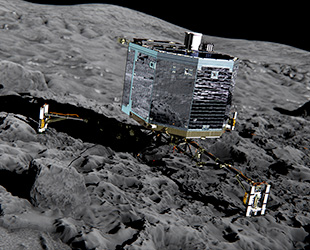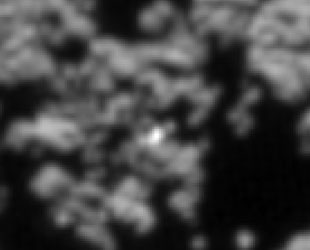June 14, 2015 — Seven months after falling silent on the side of a comet, a European probe "woke up" on Saturday (June 13) and began sending data back to Earth.
"Hello Rosetta!" the Philae lander exclaimed on Twitter to its parent orbiter and communications relay. "I'm awake!"
The first-ever spacecraft to land on a comet, the European Space Agency's (ESA) Philae probe bounced twice before touching down on comet 67P/Churyumov-Gerasimenko on Nov. 12, 2014. Designed to search for water and organics of the type that could have given rise to life on Earth, the probe operated for just about 60 hours before running out of power and entering a hibernation mode as a result of its solar panels being in the shadow of a cliff.
Mission managers held out hope that as the comet moved closer to the sun, that Philae would receive more light and be able to resume operations — which apparently is what led to the probe making contact now.
The first signals – comprising more than 300 data packets from the small three-legged lander – were received by the European Space Operations Center (ESOC) in Darmstadt, Germany at 4:28 p.m. EDT (2028 GMT) Saturday.

Artist rendition of the European Space Agency's Philae lander on the surface of Comet 67P/Churyumov-Gerasimenko. (ESA) |
"Philae is doing very well," said Stephan Ulamec, Philae's project manager. "It has an operating temperature of -35° Celsius [-31° Fahrenheit] and has 24 Watts available. The lander is ready for operations."
For 85 seconds, Philae "spoke" with its mission team on the ground, via Rosetta, in its first contact since going into hibernation seven months ago.
"That's a long time... time for me to get back to work!" the Philae probe – through its public outreach team – tweeted.
In fact, analysis of the data suggests that Philae woke up earlier, but was not able to make contact with the Rosetta orbiter to relay its status to Earth.
"We have also received historical data — so far, however, the lander had not been able to contact us earlier," stated Ulamec.

Candidate image showing a bright spot that may be Philae on the surface of comet 67P/Churyumov-Gerasimenko. (ESA) |
Since its landing in November, mission managers have been trying to pinpoint where exactly on the comet Philae came to rest. The probe rebounded twice as a result of its harpoons not firing and its ice screws failing to secure it to the surface. Earlier this month, the team announced what they believe was their leading candidate, but needed more data to confirm.
"The conditions for Philae's wake-up are becoming more and more favorable as the comet approaches the Sun," Ulamec said just two days before the signal was received. "The team has continued to prepare long term operations for Philae and its instruments in the hope that it does wake up soon."
The mission's scientists are now waiting for Philae's next contact. There are still more than 8,000 data packets in the lander's memory, which will give the team information on what happened over the past few days on the comet.
"Talk to you later!" Philae tweeted.
